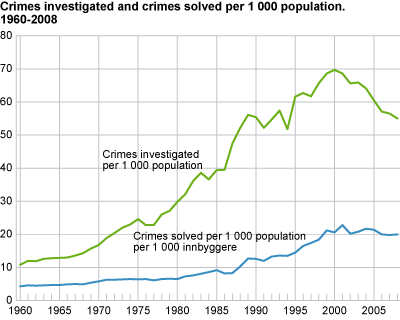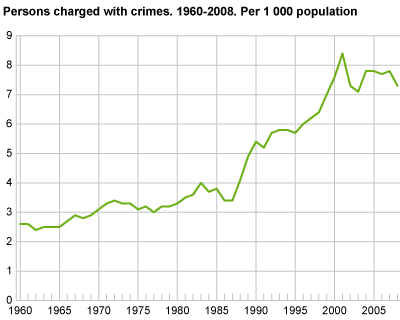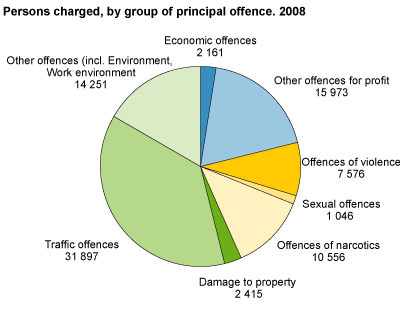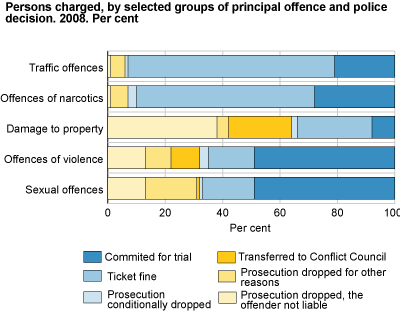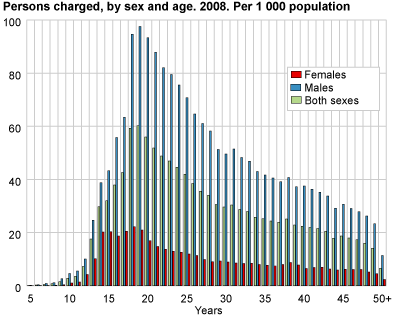Content
Published:
This is an archived release.
Fewer persons charged with theft
Investigations of more than 382 000 offences were completed in 2008, which resulted in almost 85 900 persons charged. A total of 6.7 per cent fewer thefts, and a stable clear-up rate for this type of offence contribute to a 12 per cent decrease in persons charged with theft compared with the previous year.
Police and prosecution completed the investigation of more than 264 000 crimes and 118 000 misdemeanours in 2008. One big fraud case (see textbox) results in a doubling in the number of economic offences, and the number of traffic offences is 2.4 per cent more than in 2007. A total of 6.5 per cent fewer thefts and other offences for profit, together with 4 per cent fewer offences of narcotics, resulted, however, in a 1 per cent increase in the number of completed investigated offences from the year before.
Fewer solved - and unsolved - thefts
In the five year period 2004-2008 there has been a decrease for all types of thefts, and the decrease for all thefts together is 22.2 per cent. Of the completed investigated thefts in 2008, 14 500 are solved, and almost 117 000 are unsolved, compared to 21 400 and well over 147 000 respectively in 2004. For most thefts, the prosecution is dropped because of insufficient information about the offender, and this happened in 85 per cent of the incidents in 2008.
The clear-up rate for thefts is 11 per cent in 2008, which is an equal or lower share than in the four preceding years. This applies also for each of the specified types of simple larceny, aggravated larceny and theft of motor vehicles - which in 2008 had a clear-up rate of 11, 9 and 18 per cent respectively.
Decrease in persons charged with offence for profit
In 2008, near 34 950 persons were charged with one or more crimes, and near 50 950 with just misdemeanours - a 5.6 and 1.6 per cent decrease respectively from the previous year. The decrease is particularly large for persons charged with offences for profit as principal offence; almost 8 per cent fewer than in 2007, and a 14 decrease since 2004. The number of persons charged with aggravated larceny as principal offence is 33 per cent fewer in 2008 than in 2004.
More persons charged with traffic misdemeanours
Of all persons charged in 2008, 37 per cent have a traffic misdemeanour as principal offence. Almost 19 per cent have offences of profit and 12 per cent offences of narcotics as principal offence. In total, persons charged with either offences of violence or sexual offences as principal offence constitute 10 per cent of all charged persons.
Persons charged with traffic misdemeanour as principal offence make up 63 per cent of all persons charged with just misdemeanours (excluding on-the-spot fines, see About the statistics ). The preceding years’ increase in the number of persons charged with traffic misdemeanour as principal offence continued in 2008, with a 2 per cent increase from the year before, and a 31 per cent increase from 2002.
Variation in decisions between different offences
The decisions against the persons charged in the different groups of principal offence vary considerably: For example, ticket fine is the most common decision against persons charged with traffic misdemeanour (72 per cent) and crimes of narcotics (62 per cent) as principal offence. Of the persons charged with damage to property as principal offence, 26 per cent are also given ticket fines, but the prosecution is dropped for 38 per cent because they are under 15 years of age or for other reasons not liable, and the case is solved in conflict council for 22 per cent. Of the well over 8 600 persons charged with offence of violence or sexual offence as principal offence, 49 per cent were committed for trial in court.
A total of 21 800 charged persons in 2008 were committed for trial in court. The majority of these persons either have a traffic misdemeanour (30 per cent) or an offence for profit (22 per cent) as principal offence. Persons charged with offences of violence (17 per cent) and offences of narcotics (13 per cent) also make up a large share of those committed for trial.
Most young men
Of all persons charged in 2008, 83 per cent are men; the same share as in the four preceding years. The young around age of majority are the most overrepresented. In 2008, about 9 per cent of all resident men in the age group 18-20 years were charged with offences, and about 4 per cent were charged with crimes. Persons under 40 years of age make up almost 73 per cent of all persons charged with offences in 2008.
The statistics on recidivism amongst residents in Norway show that almost half of the 72 000 persons charged in 2003 were charged one ore more times during the preceding five year period (2004-2008). The highest recidivism, with almost 69 per cent, was among men in the age group 15-17 years. As for earlier years, the share with recidivism is reduced considerably with rising age among men, while the share with recidivism increases up to the age group 30-39 years among women - where it is at its highest with 41 per cent.
More foreign citizens
Almost 13 600 persons charged with offences in 2008, which is almost 16 per cent of the total, did not have Norwegian citizenship. This is a somewhat higher share than in the years 2003-2006, when it was stable at around 14 per cent. The highest share of foreign citizens is among persons charged with offences for profit as principal offence, with 21 per cent in 2008. The share with foreign citizenship among persons charged in the groups of principal offence narcotics and traffic offences has increased relatively steadily in recent years - from around 11 per cent in both groups in 2002, to 15 and 16 per cent respectively in 2008.
The number of foreign citizens in Norway has increased considerably since the EU expansion in 2004 (compare the Population statistics ). The number of persons charged with citizenship from European countries has also increased during the preceding years, especially those with citizenship from outside the Nordic countries - which has increased from over 4 200 in 2005 to over 6 300 in 2008. The number of persons charged with citizenship from Nordic, Asian and African countries has been relatively stable or decreasing since 2004.
Large case increases the clear-up rate and other main numbersIn the statistics on investigated offences 2008 there are about 8 000 registered instances of aggravated fraud related to one big case (see also offences reported to the police 2003 ). The case causes a considerable effect in higher values for several main numbers - such as police decision, including clear-up rate, and the number of offences with several persons charged. The case consists of more than 2 per cent of all offences, over half of all economic offences and 9 per cent of all offences completed by Oslo police district. The case has, however, no significant effect on the statistics on persons charged. |
Statistics on investigated offences 2006-2010Statistics Norway has from the 2006 statistics made some adjustments in the processing routines of the basis data, in cooperation with the National Police Computing and Material Service, the Ministry of Justice and the Police, and others. These adjustments have not caused any fundamental changes in the statistics’ content compared to earlier. The statistics year 2010 is anticipated to be completed by April 2011 and the statistics year 2010 by the end of 2011. |
Tables:
Contact
-
Reid Jone Stene
E-mail: reid.jone.stene@ssb.no
tel.: (+47) 99 02 22 01
-
Siri Fjærtoft Fossanger
E-mail: siri.fossanger@ssb.no
tel.: (+47) 99 72 49 27
-
Sigmund Book Mohn
E-mail: sigmund.mohn@ssb.no
tel.: (+47) 94 32 77 22

